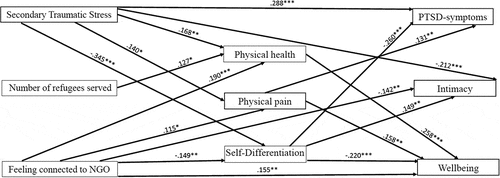Figures & data
Table 1. Aid-workers participants according to NOGs distribution (N = 317).
Figure 1. SEM model assessing the relation between STS, number of refugees served, feeling connected to NGO, physical health, physical pain, and self-differentiation in predicting PTSD-symptoms, intimacy and wellbeing of aid-workers. Note. Solid lines represent significant predictions, *p < 0.05, **p < 0.01, ***p < 0.0001.

Table 2. Aid-workers demographics, work experience, and relationship with their organizations.
Table 3. Intercorrelations between the main study measures (N = 317).
Table 4. Unstandardized regression coefficients, standard errors, and bootstrap 95% confidence intervals for predicting PTSD-symptoms, intimacy and wellbeing through physical health, physical pain, and differentiation.
